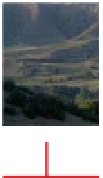Geology Reference
In-Depth Information
simple flow of individual rock frag-
ments to form a
scree
pile or
debris
apron
, to quite complex structures
that involve folds and/or faults in the
rock layers. Some examples of the
latter are shown in Figure 9.1. For such
structures to form, a plane or surface
of easy slip is required to enable the
deformation to take place; this slip
surface may already exist, in the form
of a weak bedding plane, for example,
or it may be created in the form of
a fault. Some of these structures are
indistinguishable geometrically from
those formed under an extensional
stress regime, as shown in Figure 5.4A
and B, the only difference being that
the former are formed at the surface.
Soil creep
is a process common
to many steep slopes and occurs due
to the flow of small rock or soil par-
ticles down-slope under gravity. This
causes any discernible planar surface,
such as bedding, to rotate down-
slope (Figure 9.1C) and can seriously
mislead an observer if taken as the
true inclination of the local strata.
Spectacular examples of large land-
slip structures are to be seen along the
north-east side of the Trotternish pen-
insula in northern Skye, NW Scotland,
where huge tilted blocks of Cenozoic
lavas have slid down-slope on a layer of
weak Jurassic beds (Figure 9.1F). One of
these blocks forms the famous 'Old Man
of Storr' which has been eroded into a
50 m-tall pinnacle. Blocks of this kind
that slide onto a free ground surface
will move very quickly, in the order of
seconds usually, but if the movement is
resisted at the lower end, it may progress
at a much slower rate, more akin to the
creep behaviour described in Chapter 4.
Large submarine slope failures
The structures described above are on
a scale of metres to tens of metres and
are of only local significance. However,
much larger submarine slope failures
have been recorded along both active
and passive continental margins.
Large slope failures of Pleistocene (late
Cenozoic) age recently investigated
in southern Chile involve volumes
of displaced material amounting to
several hundred cubic kilometres.
Such active-margin structures are
thought to be activated by earthquakes
related to the subduction process.
Very large slope failures have also
been recorded along passive margins,
a famous example being the
Storegga
slide
off the coast of Norway, with an
estimated displaced volume of over
3000 km
3
, along ~ 290 km of coastal
shelf. The volume of deposited ma-
terial has been compared to an area
the size of Iceland covered to a depth
of 34 m and is attributed to a build-up,
on the edge of the continental shelf, of
fluvioglacial sediment from the last Ice
Age. This collapse is believed to have
triggered a huge tsunami in the North
Atlantic, which has left traces around
the coast of Scotland in the form of
a layer of debris, dated at 6100
BCE
,
in raised beach deposits ~ 4 m above
current sea level, and must have had
a catastrophic effect on the contem-
porary Mesolithic population.
gliding
). Sliding can take place on
slopes of only a few degrees provided
that the weight of the fault sheet is sup-
ported by a high enough fluid pressure
within the fault zone (
see
discussion in
Chapter 5). The down-slope progress of
the nappe will be resisted by the rock
mass at the end of the slope, i.e. beyond
the toe of the nappe, unless the basal
fault escapes onto the ground surface
(compare Figures 9.1D and E) in which
case the nappe may move as a coherent
block, as in Figure 9.1E. More probably,
it will become internally deformed by
folding and/or faulting because of the
pressure exerted at its lower end, as in
Figure 9.1D. Where the sliding nappe
is unrestricted by such resistance, it
may travel at high speed, comparable
with that experienced in catastrophic
landslides, but in the more usual case
of restricted movement, the rate of
deformation will correspond to that of
'normal' ductile flow in the solid state.
Examples of gravity gliding nappes
have been described from various
mountain belts, especially the Western
European Alps, which contain some
of the best-known examples, one of
which is illustrated in Figure 9.2. The
initiation of the gliding process in
these situations is usually a response
to crustal thickening due to compres-
sion in the central part of the mountain
belt. Such a process, involving perhaps
many thrust sheets piled on top of one
another, is gravitationally unstable
and will eventually lead to a reduc-
tion of crustal thickness by the lateral
spreading of the over-thickened crust;
this is termed
gravity spreading
.
Whereas gravity gliding relies on
a concentration of movement on a
basal fault, gravity spreading implies
9
74
75
Down-slope movement of large
fault-bounded sheets under
gravity
Large sheets of rock (
nappes
), many
kilometres in extent, that rest on a
basal fault, may experience sliding
under gravity (
gravity sliding
or
gravity



Search WWH ::

Custom Search